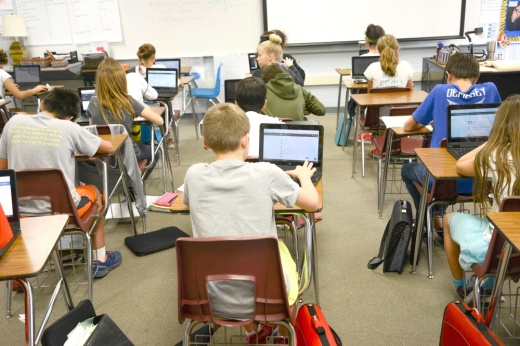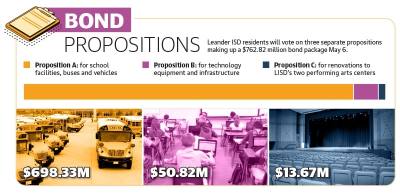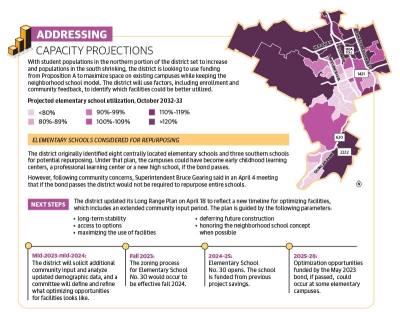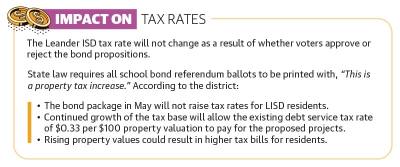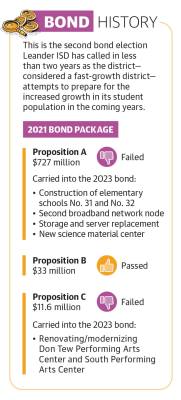Registered voters within Leander ISD will vote on a $762.82 million bond package May 6 as the district hopes to acquire funding for new facilities, technology and infrastructure, and renovations to two performing arts centers.
The bond election comes as the district attempts to address unbalanced growth in the region. LISD is projected to grow from around 42,000 students to 51,083 by 2032, according to data compiled by Population and Survey Analysts. LISD’s enrollment increased by 3,554 students from 2016-21.
However, changes to the district’s population vary across its boundaries with much of the growth expected to occur in the northern portion of the district while the southern portion dwindles.
“The challenge is how do we add new facilities in the north to manage the growth there, but also how do we remain fiscally responsible utilizing our facilities as best as we can in the center and the south of the district,” Superintendent Bruce Gearing said.
This is the second bond election for LISD in less than two years. The district called for a bond election in November 2021, asking voters to decide on a $772 million package to fund a variety of projects similar to the ones laid out in the latest proposal. Voters passed one of the three propositions on that year’s ballot.
“That caused us to really pause and re-evaluate what it is that we needed to do,” Gearing said.
Capital improvements
The May bond package has three propositions. Proposition A includes $698.33 million in funding for facilities, school buses and vehicles. It includes two new schools—Elementary School No. 31 for $71.4 million and Elementary School No. 32 for $79.9 million—to be constructed in LISD’s growing northern section.
Money could also go to repurposing facilities to the tune of $37 million-$50 million, transforming elementary schools projected to be under capacity into early childhood centers, a professional learning center or for relocating New Hope High School.
However, after several Steiner Ranch parents spoke at a special-called board meeting April 4 against the district’s plan to repurpose schools, LISD trustees and administration shifted the direction of what repurposing campuses would look like.
Steiner Ranch parent Dean Rheaume said long-range enrollment forecasting, which informed the district’s plans for repurposing campuses, is difficult when it comes to elementary schools.
“They’re difficult because kindergarteners 10 years from now simply aren’t humans today,” he said.
A parent-led group called Save Our Four Points Schools spoke at several recent board meetings in an effort to keep three schools—that were initially slated to be repurposed as part of Proposition A—open.
The district has since hosted additional forums to get community feedback, LISD Chief of Communications Crestina Hardie said.
Gearing led a presentation at the April 4 meeting, explaining how the district plans to repurpose campuses with community input at the forefront.
“We have listened to the community, and we understand that there is a strong desire to keep neighborhood schools open,” Gearing said. “We believe that there are ways to repurpose campuses that keep schools open while addressing district needs and also bringing some exciting, engaging new opportunities to neighborhood schools.”
Gearing said instead of closing and repurposing the underutilized schools, the district could achieve the same goal of maximizing facilities by repurposing portions of those schools.
“If, however, a particular school’s community decides that it no longer makes sense for us to keep the school open, there is still the possibility of closing a school and repurposing the entire facility,” Gearing said.
Modernization projects, meanwhile, would involve replacing carpet; flooring; ceilings; lights; heating, ventilation and air conditioning systems; and furniture at several campuses.
Trish Bode, Place 1 trustee and board president, said many of these items stem from past failed bond proposals and were brought back after receiving community input. She added modernization projects are important for safety and security at schools in addition to saving money spent on maintenance.
“There was a revisit of, ‘Let’s make sure when we go to the community that we’re looking at things we need, that we’re being responsible with tax dollars,’ and this is that result,” she said. “I would say there’s more of a need because these items are aging, and we’ve got some newer things on here that weren’t there last time.”
In Proposition B, LISD would secure $50.82 million for technology equipment and infrastructure. Projects include refreshing and upgrading the district’s network, providing second-grade students with Chromebooks, and replacing LISD’s network server.
When the community approved one of the three 2021 propositions, it authorized LISD to spend $33.3 million on the replacement of technology and interactive panels in each classroom. However, the funding to install those panels would have been paid for by a failed proposition.
“In this bond we’ve actually taken all of the technology pieces—the end-user devices, including those interactive panels, and all the infrastructure that’s required to install them—and put all of that into Proposition B,” Gearing said.
Proposition C would renovate the Don Tew and South performing arts centers. According to district administration, upgrades to the facilities’ heating and air conditioning systems as well as other remodeling projects are more than 20 years due.
Bonds allow school districts to borrow money to be used to construct new buildings, acquire land, invest in technology, buy vehicles and make other large purchases.
If approved, school districts then sell bonds to investors, who are later repaid the initial cost plus interest.
According to LISD officials, the tax rate for residents will not increase based on the results of the election as the value of taxable properties within the district continues to increase, allowing LISD to fund projects with the existing debt service tax rate of $0.33 per $100 property valuation. Despite this, rising property values could result in higher tax bills for residents.
“That tax rate is adequate to pay our current debt payments, to continue to defease debt, to pay off debt early whenever we can,” Gearing said. “And also it has enough capacity in those $0.33 to accommodate certainly this bond that’s on the ballot for this May.”
Community concerns
Texas Parents United, a political action committee made up of parents and community members, opposes the largest of the propositions—the $698.33 million Proposition A.
The group points to a conversation Nov. 15, when Gearing recommended during a school board meeting that trustees look at repurposing the Citizens Facility Advisory Committee and providing an opportunity for the committee to engage in extensive community listening projects.
“The board did not do that; they did not follow that recommendation,” Texas Parents United President Laura Davis said.
Texas Parents United is advocating for the board of trustees to conduct a community listening project to “improve the long-range plan” and create “small, targeted, well-vetted bond proposals” for a November election.
On the other side, some are worried that if a bond is not passed now, it could cost the district more in the future.
Celeste Fahnert, who served on the bond steering committee and is part of the All In LISD political action committee in support of the bond, said she believes a bond failure would harm the district, pointing to HVAC systems “on the verge of failure.”
“If one of those systems fails in the middle of the school year, that means the school is closing while they repair it,” she said. “That could take a month, two months. There’s so many things that would negatively impact our community.”
Fiscal concerns are another factor, one that weighed into Place 7 board member Paul Gauthier’s decision to vote against the proposal—the only trustee to do so.
Per state law, the maximum maturity of a bond—the date by which LISD has to repay the money it receives—is 40 years. The higher bond rating a district has, the lower the potential interest rates. LISD has the second-highest rating: AA. However, interest rates are subject to market conditions and could change.
“It just depends on what you are willing and able to pay back those rates,” Gauthier said. “[Bonds are] just the most expensive way to take out a loan, so why are we taking out loans anyway when we have a $400 million-a-year income?”
Instead of calling for bonds, Gauthier said it would be more fiscally responsible to save funds the district brings in through state funding and other revenues to pay for the projects.
Developing a plan
Prior to calling an election, LISD’s Citizens Facility Advisory Committee—made up of six subcommittees and a steering committee of local residents—formed to create a bond package. Each subcommittee brought recommendations to the steering committee, which delivered proposals to the board.
In January, the steering committee recommended the board call a bond package ranging from $563 million-$601 million. The administration then brought additional proposals aligned with LISD’s long-range plan—an evolving 10-year itinerary to ensure facilities accommodate changes to the district’s population.
“I know some people have said the process was rushed,” Fahnert said. “While it may feel like it was from the outside, we spent a lot of time and thought, even outside of our meetings, processing that information alone.”
Mike Herrera, a steering committee member, said the group was able to meet with the district’s chief financial officer and ask LISD staff questions. However, not all of the steering committee members understood “how much steering we could do” regarding the cost of certain projects.
Gearing said if the bond fails, the district would likely have to look at changing attendance zones, making it “difficult to maintain the neighborhood school concepts.”
Furthermore, he said LISD would have to put off renovations to 30-year-old facilities, install portable buildings and pay for potential repairs out of the district’s general fund in addition to bringing another bond proposal to the voters in November.
“There are consequences, certainly, for if this bond doesn’t pass,” Gearing said.




